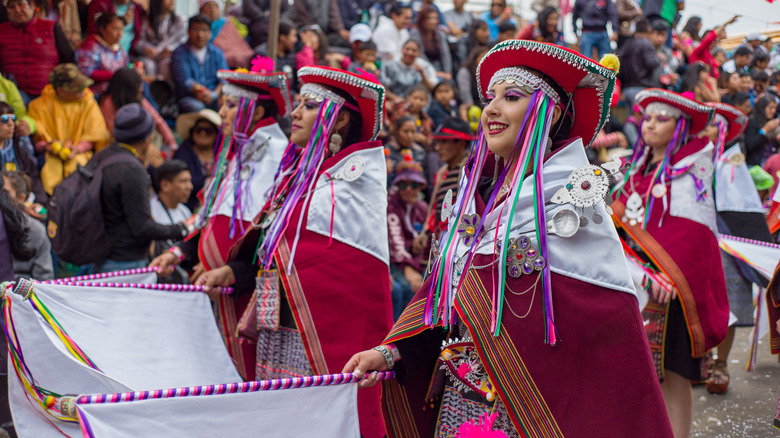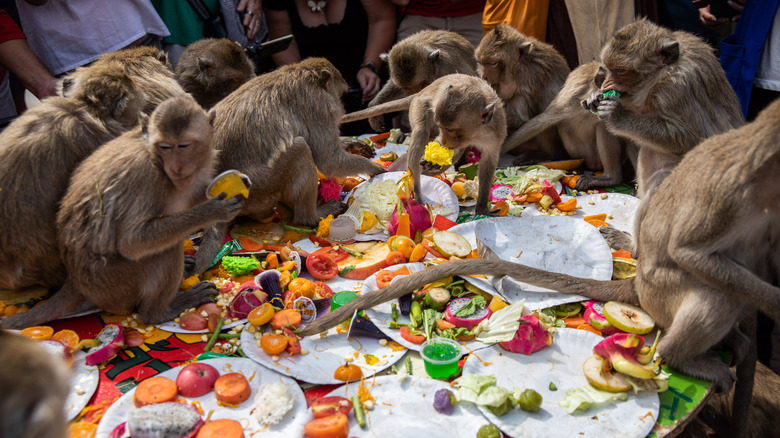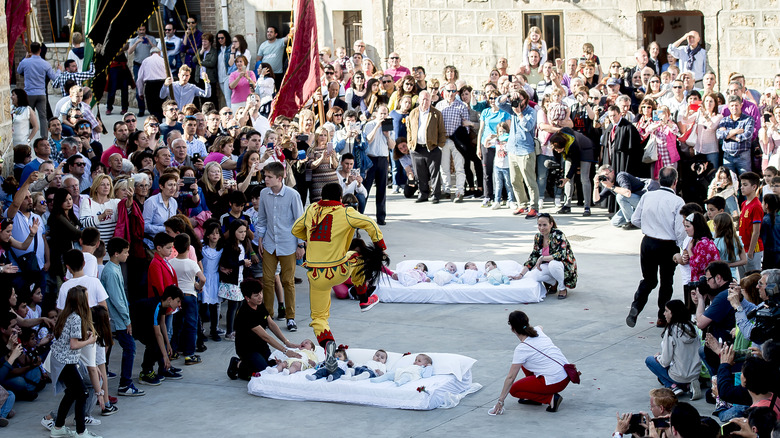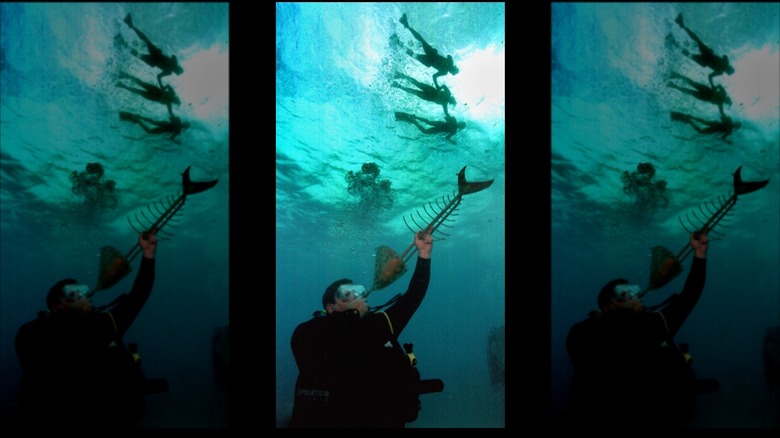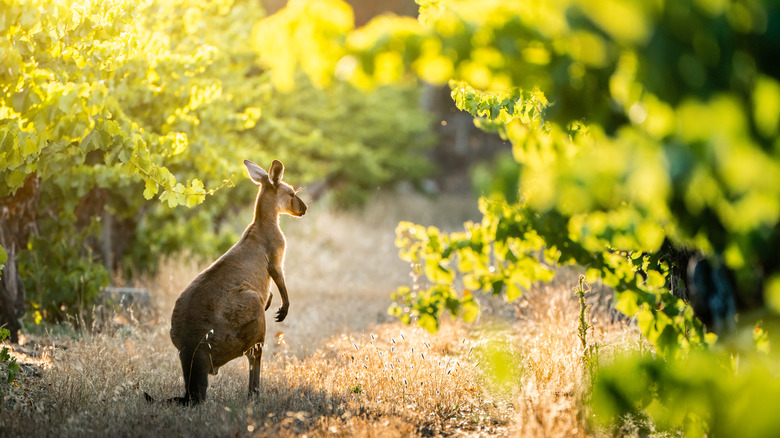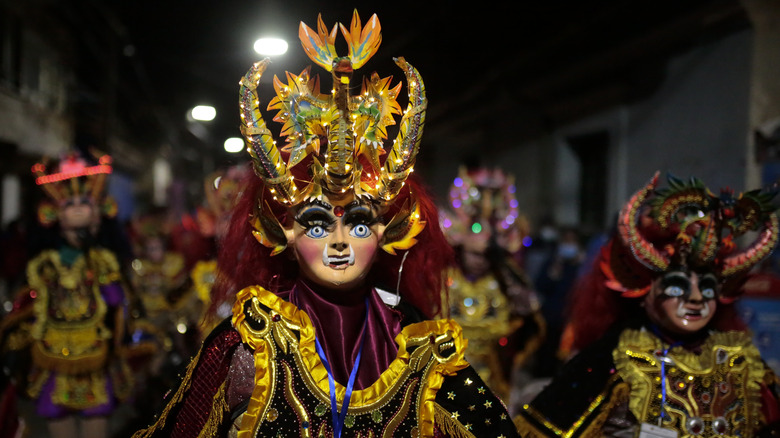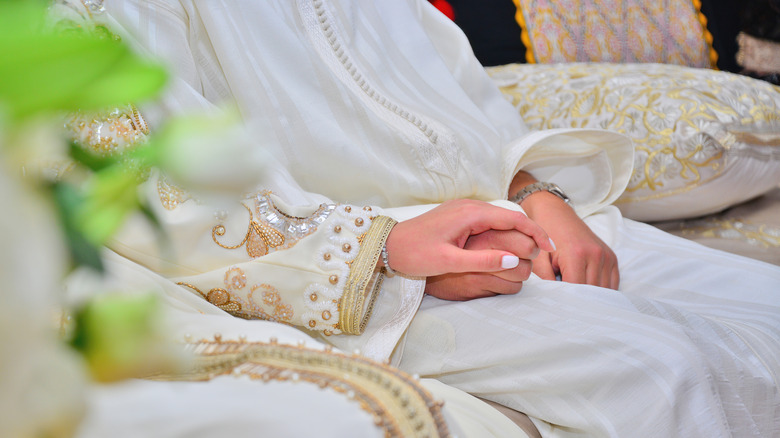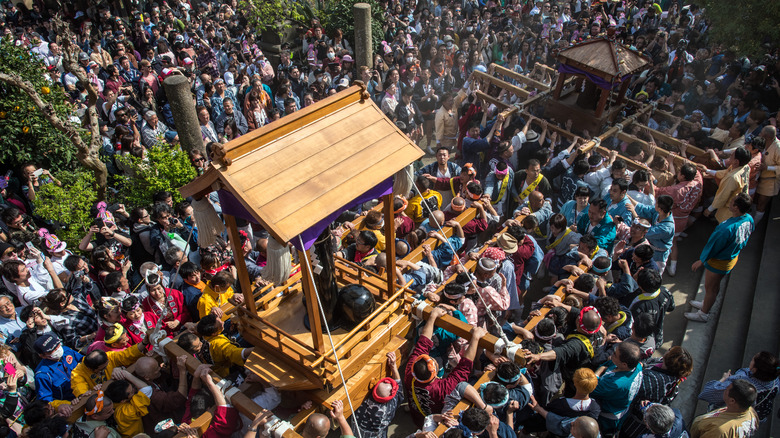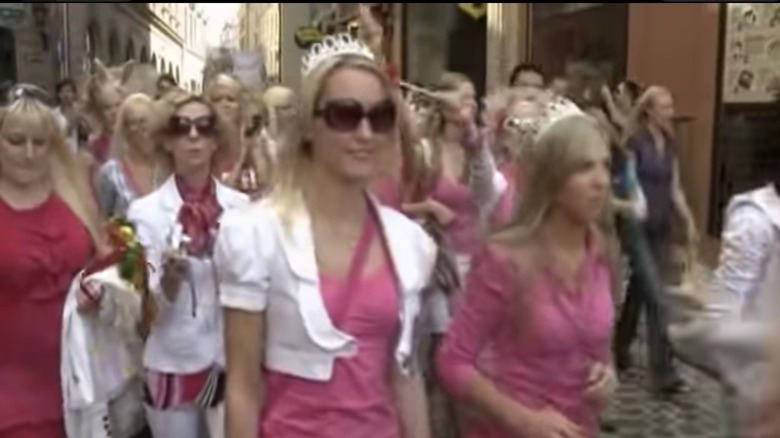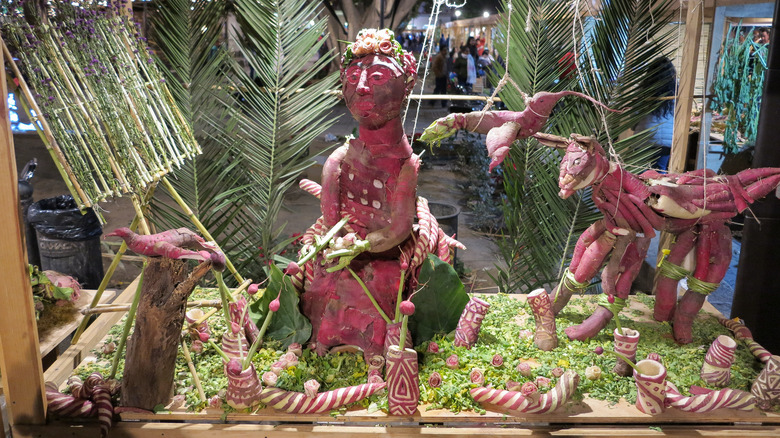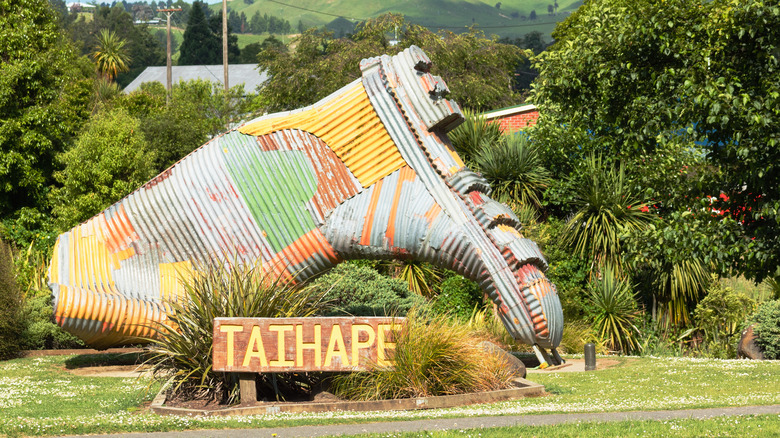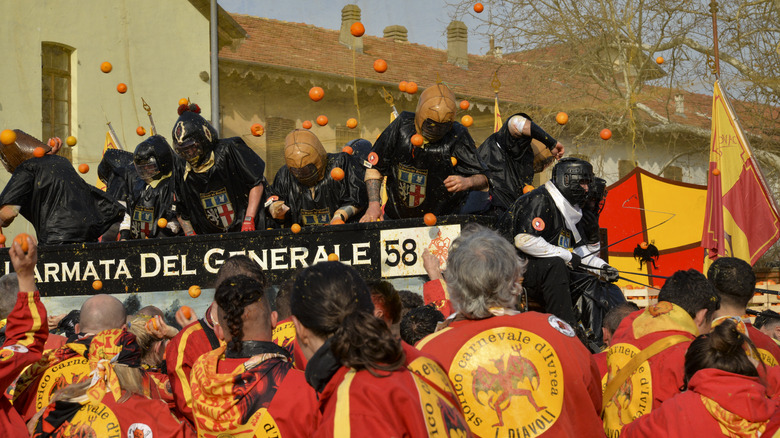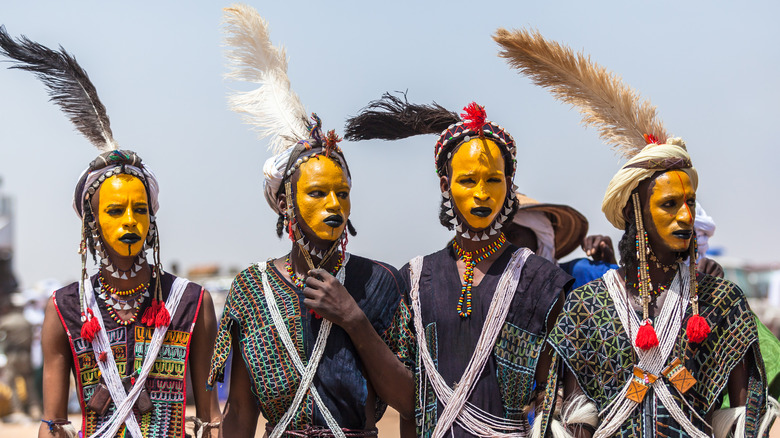The Most Unique Festivals Around The World
When one thinks of festivals, the most common associations are food, stalls, and live music. Often, they are meant to celebrate someone or something, whether a season, holiday, country, (sub)culture, or religion. Other times they simply bring together like-minded people. In America, this is generally how festivals go.
But what about a festival dedicated to jumping over babies? Or a festival dedicated to a boot? Or one where attendees get to throw oranges at each other to spite "the man?" Around the world, there are tons of such festivals dating back hundreds or even thousands of years — usually with religious origins that stretch back centuries or even millennia. Others have developed over the past few decades and exist because they can and people enjoy them — even here in the good ole' US of A.
From the Festival of the Steel Phallus in Japan to the Underwater Music Festival in Florida and everywhere in between, here are some of the world's most unique festivals.
Lopburi Monkey Banquet (Thailand)
Every good festival boasts food, but at the Lopburi monkey banquet in Lopburi, Thailand, the food is not for people — instead it is for the guests of honor, the area's thousands of macaque monkeys. The festival is held on the last Sunday of November every year.
According to Atlas Obscura, reverence for macaques goes back at least 2,000 years. Its origins lie in the legend of Hanuman, the monkey king who helped the divine prince Rama rescue his kidnapped wife. As thanks for Hanuman's help, monkeys not only became symbols of good fortune and prosperity — they got a whole lot of respect in the form of food.
Although respect for macaques has ancient roots, the banquet on their behalf is relatively recent. According to Vice, the feast was first held in 1989 to promote Thailand's tourism industry. Visitors are also treated to live performances and various cultural displays, including dancers dressed as monkeys. The lavish offerings of the banquet include nearly two tons of food for the macaques to enjoy. Visitors to the monkey banquet should be aware that there are some risks involved in such a feast. Once the monkeys get used to the crowds, they are known to attach themselves to festival-goers and sometimes scratch and bite them. However, one Israeli tourist interviewed seemed to enjoy the challenge. Looks like attitude is everything!
El Colacho baby jumping festival (Spain)
Spain has its share of unusual festivals, but perhaps the most unique is the El Colacho baby jumping festival, which takes place on the Sunday after the Feast of Corpus Christi in late spring or early summer. This unique blend of Catholicism and old pagan rituals has been traced back to the 1620s, though it's unclear exactly how the festival began, per National Geographic.
The festival's most fascinating (and alarming) aspect is baby jumping, which is just what it sounds like. Babies are laid on mattresses in the street while men dressed as red and yellow devils ("Colacho") jump over them. People believe this ritual allows the devils to take on the babies' sins while protecting the infants from sickness. It effectively parallels Christian baptism — but in a much more dramatic event. In addition to leaping over the community's most recent additions, the Colacho run through the streets insulting bystanders and whipping them with horsetails. But when the "atabalero" show up, "el salto del Colacho," or "the flight of the devil," takes place as these pious men chase the devils away.
Historically, only babies born in the village of Castrillo de Murcia in Northern Spain during the year preceding the festival were eligible for jumping. However, people worldwide have started bringing their babies to the festival as its popularity has gone global.
Underwater Music Festival (USA)
Music lovers have no shortage of festivals to attend, but the Underwater Music Festival held in the Florida Keys is one that attendees are unlikely to forget. According to Atlas Obscura, the festival was the brainchild of Bill Becker, who wanted to raise awareness for the preservation of coral reefs. It appropriately takes place at Looe Key Reef, part of North America's only living barrier reef.
How does an underwater music festival work? The organizers blast a playlist through underwater speakers. It is also streamed on the radio for non-mermen/scuba divers. Divers and snorkelers play along on unique musical instruments such as the "trom-bonefish" and "Fluke-a-Lele," designed for the occasion by a local artist.
The festival boasts ocean-themed songs (of course) and has an overarching theme related to the year's happenings. For example, the 2008 theme was "EEL-ection Antics" (featuring Barackuda Obama, Hillary Clin-Tuna and John McClam). In 2009, the theme was "Yellow Submarine" (featuring Ringo Starfish and Paul McCarpney). Although the festival was on hold between 2015 and 2019 due to lack of funding, it has since returned.
Throwing of the Grape Festival (Australia)
The Throwing of the Grape Festival in Australia began in 2011 to celebrate the first wine harvest at Oakover Winery in Australia. It has the typical food, wine, and music one would expect from such a festival, but according to the Sydney Morning Herald, it also has some unique grape-related activities.
There are activities for teams and soloists alike. One is grape squashing, a group competition in which teams of four use their feet to squash as many grapes as possible before the timer runs out. In contrast, grape throwing is an individual sport in which people throw grapes at each other in a massive free-for-all. According to the PerthGirl blog, written by a festival attendee, "getting graped" is an optional part of the day. But for those who choose to take part, event organizers recommend bringing a change of clothing due to the high probability of grape-related carnage.
In addition to the grapey activities, the festival includes a gourmet buffet-style lunch, live music, mechanical bull riding, water dunk tanks, and of course, wine tasting. For those who want to relax, picnicking is also an option. Regardless of whether one is a champion grape-squasher or just wants to listen to good music in a fun environment, the Throwing of the Grape has something for everyone.
Carnaval de Oruro – Dance of the Devils (Bolivia)
While Carnival is celebrated throughout the Christian world before Lent, local cultures have created their own unique celebrations. In Oruro, Bolivia, the Uru people combined their local Indigenous customs with the colonial Christian iconography and religion from Spain to create a Christian-themed celebration of Uru heritage and culture (per UNESCO).
According to Atlas Obscura, Carnaval de Oruro is characterized by elaborate, brightly colored costumes, which the Museum of Cultural Masks notes represent the archangel Michael and his army of angels in their battle against an army of devils. Participants perform the "Diablada," or "Dance of the Devils," which portrays this battle and the devils' ultimate defeat.
While the Diablada predates the Christianization of Bolivia, it has become a tribute to the Virgen del Socavón (the Virgin of the Mineshaft). This incarnation of the Virgin Mary is the patroness of Oruro. According to Tradition in Action, she interceded on behalf of the town when a monster devil called Wari tried to destroy it with plagues because the people where converting to Christianity. She confronted Wari and slew him with a flaming candle, making her a focal point of veneration in the area. After an image of the Virgen del Socavón miraculously appeared in an abandoned silver mineshaft in 1756, her veneration was cemented. Since Mary wields a candle as her weapon of choice, her feast day originally fell on February 2 — Candlemas. Since then, however, it has been moved to coincide with Carnival celebrations.
Imilchil Marriage Festival (Morocco)
Festivals are always a great place to find love, and none proves this cliche better than Morocco's Imilchil Marriage Festival. According to Morocco World News, this festival sprang from the Berber equivalent of "Romeo and Juliet." In this Amazigh legend, two star-crossed lovers from opposing tribes wanted to marry but couldn't. The couple cried themselves to death, birthing two rivers with their tears. Their suffering continued in the afterlife, as they were separated eternally by a mountain. Today, the rivers are accordingly called Isli (his) and Tislit (hers).
Understandably distressed by this tragic tale, the young lovers' families established the marriage festival as a day for members of the tribes to marry each other. Today, the festival is more of a match-making opportunity for young men and women from different tribes to meet. Sometimes as many as 40 couples becoming engaged. These couples would otherwise not have the opportunity to meet given the rigid social structure of the Berber tribes to which they belong.
Women attend the festival in traditional colorful attire and with their fathers as chaperones. Men who are seeking partners wear all white. Those who become engaged participate in an elaborate engagement ceremony, with weddings to take place at a later date. While this festival has historically been closed to outsiders, the event has gradually become open to visitors . Today, being invited is considered an honor, and outsiders are expected to behave respectfully.
Kanamara Matsuri festival (Japan)
This one might strike westerners as strange due to its uninhibited display of male genitalia. According to Japan Travel, the festival brings together phalluses and blacksmithing — a combo that actually makes sense in the festival's context.
The event attracts married couples asking for blessings and fertility as well as sex workers seeking protection from sexually transmitted diseases. But this at first seems to have little to do with the honorees. According to UPI, the festival honors the Shinto divine couple of Kanayama-hiko and his female counterpart, Kanayama-hime. These two deities are considered the patrons of blacksmithing and other metallurgical pursuits, but they're also revered as fertility gods. And this is where the phalluses come in — combine metallurgy and penises and you get Kanamara Matsuri, or the Festival of the Steel Phallus.
So how did this start? The festival ultimately might combine two different traditions. One says that the divine couple healed the goddess Izanami after her genitalia were burned while giving birth to a fire god — thus the sexual healing and fertility aspect. The other story involves a demon with sharp teeth installing himself in a woman's genitalia, making intercourse impossible and ending both her marriages. Her ordeal only ended when a blacksmith (presumably under the patronage of the divine couple) crafted a metal penis and used it to break the demon's teeth. This legend is commemorated with a steel penis outside the Kanayama Shrine, where the festival is held. Together, the stories bring together sexual healing, phalluses, and metalwork in a truly unique combination.
The Go Blonde festival (Latvia)
This one started in 2009, according to CNBC. The 2008 recession hit the small Baltic country of Latvia quite hard, shrinking its economy 18% in 2009. The European Union bailed the country out with nearly $9 billion, but there was still much economic pain for the Latvians. So a group of women called the Latvian Association of Blondes decided to start the Go Blonde festival in the capital Riga as a way of bringing cheer, encouraging economic growth, and providing a welcome distraction from the problems of everyday life.
The festival differs from year to year, but it involves a parade of blonde women (natural and dyed are both welcome), live music, and different types of contests. In 2010, for instance, there was a Marilyn Monroe lookalike contest, in which participants were judged according to who could most closely resemble the iconic blonde actress. According to the Sydney Morning Herald's Traveller Magazine, there were also sporting events pitting teams of blonde contestants against each other, a blonde orchestra, "blonde credit cards," and drives to raise funds for Latvian children's charities.
Traveller Magazine reports the festival was supposed to be an annual event. There was even a petition for UNESCO to make May 31 — a day that coincides with the festival — "International Blondes Day." It is unclear if the festival is still a thing, but the last confirmed edition took place in 2011.
Night of the Radishes (Mexico)
The Mexican state of Oaxaca is known for its colorful indigenous traditions, but it also hosts a more recent festival that began basically as an advertising campaign for local vegetable merchants. According to the culture magazine Mexico Desconocido, the festival has its roots in the marketplace, where merchants would sell vegetables — particularly radishes — for making Christmas lunch and dinner.
Atlas Obscura reports that vendors would carve their vegetables into figurines to make them more attractive to shoppers. In 1897, the city's municipal president decided to turn this into an actual festival and competition that would take place on December 23 — right before the Christmas vigil.
Today, the festival is simple: Local vendors and artists take radishes and carve them into figurines. Taking place in predominantly Catholic Mexico right before Christmas, it's no surprise that many of the figurines are of a religious nature. So, one can see radishes carved to look like ordinary people, the Virgin Mary in her various apparitions, or even Michelangelo's famous sculpture La Pieta. The festival also includes musical acts, street fairs, and a fireworks display at the end — not a bad way to celebrate the hours leading up to Christmas Eve.
Taihape Gumboot Festival (New Zealand)
The town of Taihape, located in the middle of New Zealand's North Island, is known for a massive sculpture of a "gumboot," which is a regionalism for rain boots. This festival is actually based on a fictional television character. According to Atlas Obscura, satirist John Clarke played a typical "Kiwi bloke" named Fred Dagg who lived in Taihape. Since Dagg wore gumboots — like many of the actual farmers and rural inhabitants of the area — the nondescript town decided to associate itself with the footwear, becoming the "gumboot capital of the world."
The small town saw an opportunity to rake in tourist dollars in 1985 and began throwing the festival on "Gumboot Day," which now falls on the Tuesday after Easter. The signature event of the festival is the Gumboot Toss, which sounds exactly like what it is — a competition to decide who can throw a gumboot the farthest. But there are also displays of local traditions and agricultural practices, according to the New Zealand Herald. For instance, sheep farmers come to show off their animals, while children take part in an art competition. There is also a competition that involves trying to pop balloons with a whip.
So while this festival may not be steeped in centuries of tradition, it seems like it's a ton of fun. It's also unique — it takes imagination to craft an entire category of events around a type of shoe.
Carnevale d'Ivrea (Italy)
The city of Ivrea in Northern Italy hosts a carnival every Lent that commemorates standing up to tyrants. According to The New York Times, some say it began when a bride named Violetta was selected by local lord Raineri de Biandrate for what was known as "jus primae noctis." In the Middle Ages, this law — whose existence, according to Atlas Obscura, is disputed — gave the local lord the right to bed any bride on her wedding day. Violetta killed him, and the townsfolk celebrated their freedom from this tyranny.
Unsurprisingly, the festival is considered a celebration of the triumph of the little guy over "the man." The centerpiece of the event is the battle of the oranges, which is exactly what it sounds like: People break up into teams and throw oranges at each other. But it's not just a massive free-for-all. The majority of the city's inhabitants represent angry townsmen divided into several teams, which even have their own uniforms (as seen above). Armed with oranges, they attack the representatives of the local authority (aka "castle defenders"), who often dress as armored knights or some other representation of authority. For three days, the two sides battle it out in the city streets and squares, and sometimes injuries do happen.
The only question left unanswered is exactly why oranges are used. The region doesn't grow the fruit — the ammunition is imported from Southern Italy and Sicily. Regardless, it sounds like an absolute blast — so much so that it's considered a manifestation of Italian culture of "international relevance," according to the Foundation of the Historic Carnival of Ivrea.
Gerewol Festival (Chad)
The Wodaabe are a nomadic cattle-herding subgroup of the Fulani, migrating around the Sahel region of Niger, Chad, and Northern Nigeria, per Atlas of Humanity. They are also somewhat distinct for the relationships between the sexes. According to Dr. Kate Lister of Leeds Trinity University (via Vice), the group does not practice monogamy and women get to choose their lovers at a festival called the Gerewol.
When one imagines a beauty pageant, it's usually women who compete. In the Gerewol festival, however, the competitors are men, who deck themselves out in makeup made from clay and other dyes, jewelry made from shells, and their best robes. They then sing and dance for hours on end in 104-degree heat hoping to impress the female spectators and judges, who are often the daughters of men who have won the competition in the past.
When a judge chooses her man, he gets the honor of sleeping with her — regardless of whether either is married. The judge may also elect to marry the man. Obviously, Western observers might wonder if there is any jealousy involved. According to Dr. Lister, it is considered a societal honor for a man to be picked out for a sexual encounter with the high-status judge — even for his wife. The same is true for the husband of the judge. In Wodaabe society, beauty talks, and as Lister puts it, it's more dignified than "getting tanked up on WKD and being fingered round the back of Wetherspoons." Think of it kind of like a dating app, but in-person and without the awkwardness and contrived small talk.
